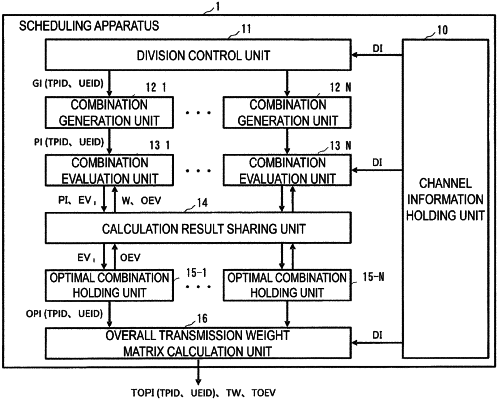| CPC H04W 72/12 (2013.01) [H04L 5/0035 (2013.01)] | 6 Claims |

|
1. A scheduling apparatus comprising:
a division controller configured to divide a communicable area covered by a plurality of transmission points into a plurality of areas;
a combination generation device configured to generate candidate patterns of combinations of transmission points of the plurality of transmission points and user terminals for each of the plurality of areas;
a combination evaluation device configured to calculate evaluation values of the candidate patterns for each of the plurality of areas based on channel information representing radio wave states between the transmission points and the user terminals;
an optimal combination holding device configured to hold a pattern having a highest evaluation value among the candidate patterns as an optimal combination pattern in assigning a radio resource for each of the plurality of areas;
a calculation result sharing device configured to output an evaluation value of a respective optimal combination pattern held for each of the plurality of areas by the optimal combination holding device to the combination evaluation device for sharing with the plurality of areas as first shared information when a first timing occurs; and
an overall transmission weight matrix calculation device configured to calculate a transmission weight matrix for the communicable area based on a result obtained by combining the optimal combination patterns of the plurality of areas when a second timing after the first timing occurs, wherein after the first timing, the combination evaluation device uses the first shared information along with the channel information to calculate an evaluation value of a respective candidate pattern for each of the plurality of areas.
|